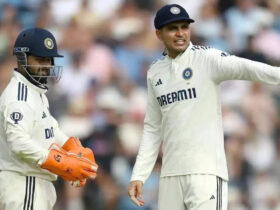IND vs ENG 1st Test: Shubman Gill’s India Faces Pace Challenge as Bumrah Remains Key
As the Indian cricket team, led by the young Shubman Gill, prepares to lock horns with Ben Stokes’ England in the first Test at Headingley, Leeds, the ghosts of swing and seam loom large. Over the past decade, India has often struggled in English conditions, haunted by the mastery of legends like James Anderson and Stuart Broad. Though the duo has retired, England’s attack, spearheaded by the experienced Chris Woakes and bolstered by emerging talents like Brydon Carse, Jamie Overton, and Josh Tongue, promises to test India’s resolve in conditions that favor pace and movement.
With the series kicking off in just a couple of days, the spotlight falls on India’s strengths and vulnerabilities. Can Gill’s men overcome their historical struggles against swing bowling? Will their over-reliance on pace spearhead Jasprit Bumrah prove to be a double-edged sword? Let’s dissect the key aspects of this intriguing contest.
Bumrah: India’s Trump Card and Burden
Former England pacer Stuart Broad, speaking on his podcast For the Love of Cricket, emphasized the importance of Jasprit Bumrah in determining the series outcome. Broad warned, ‘If Bumrah plays all five Tests, England will be in deep trouble. He’s capable of picking up a truckload of wickets.’ And the stats back this up—Bumrah, with over 150 Test wickets at an astonishing average of under 21, is a generational talent. His recent heroics in the Border-Gavaskar Trophy in Australia, where he scalped 32 wickets at 13.06, showcased his ability to dismantle batting line-ups single-handedly.
However, India’s over-dependence on Bumrah is a glaring concern. In Australia, no other bowler consistently threatened, and with Mohammed Shami absent for this tour due to injury, England’s batsmen might fancy their chances once they navigate Bumrah’s fiery spells alongside Mohammed Siraj. Chief selector Ajit Agarkar has already hinted that Bumrah might not play all five Tests to manage his workload. This puts added pressure on youngsters like Prasidh Krishna and Arshdeep Singh, as well as the experienced Shardul Thakur, to step up and support the pace attack.
Kuldeep’s Spin: A Potential Game-Changer
India’s spin department holds a wildcard in Kuldeep Yadav. The last time England’s aggressive ‘Bazball’ batters faced Kuldeep, during the home series earlier this year, they struggled to read his variations and loop. Kuldeep claimed 19 wickets in four Tests on pitches that weren’t rank turners, turning the series in India’s favor after a shaky start. Though his memories of England aren’t pleasant—having endured a tough outing at Lord’s in 2018 on a seaming track—Kuldeep, now 30 and more seasoned, could exploit any assistance from the Headingley surface to bamboozle the hosts.
Batting Woes: Can Openers Set the Tone?
India’s batting has historically faltered against swing in England. The mantra for success is patience—waiting out the movement before playing shots—but Indian batters have often been guilty of playing away from their bodies, leading to inevitable collapses. The current top order, featuring the explosive Yashasvi Jaiswal and the seasoned KL Rahul, must emulate the grit shown by Rohit Sharma and Rahul in the 2021 series, where India led 2-1 before the final Test was curtailed. Rohit’s resolute 127 at The Oval, a knock spanning 256 balls with just six boundaries, was a masterclass in tempering aggression with caution.
Under-fire captain Shubman Gill faces scrutiny over his away record, averaging a modest 35 in Tests. His struggles against the moving ball are well-documented, and his surprise elevation to captaincy has drawn criticism from former players like K. Srikkanth and Wasim Jaffer. Srikkanth remarked to Times of India, ‘Gill hasn’t even cemented his place in the Test XI. How can he lead?’ Yet, Gill can draw inspiration from Virat Kohli’s transformation in England. After a dismal 134 runs in 10 innings in 2014, Kohli returned in 2018 to amass 593 runs, including two centuries, proving adaptability is key.
Fielding Frailties: Slip Cordon Under the Scanner
Beyond batting and bowling, India’s slip fielding remains a perennial Achilles’ heel. Dropped catches in the cordon have cost them dearly in past tours. In England, slip catching is notoriously challenging due to smaller sightscreens and the late swing of the Dukes ball, which often deceives fielders even after taking the edge. With the team coming off the IPL, where slip practice is minimal, intensive drills will be critical to avoid repeating past mistakes at crucial junctures.
As the first Test approaches, India stands at a crossroads. Their fate hinges on Bumrah’s brilliance, Kuldeep’s guile, and whether their batters can weather the storm of England’s pace attack. For Shubman Gill, this series is not just a test of his team’s mettle but also a chance to silence doubters and cement his leadership credentials. Will India rise to the occasion at Headingley, or will England’s new-look pace battery exploit their frailties? The battle lines are drawn, and the cricketing world watches with bated breath.





















